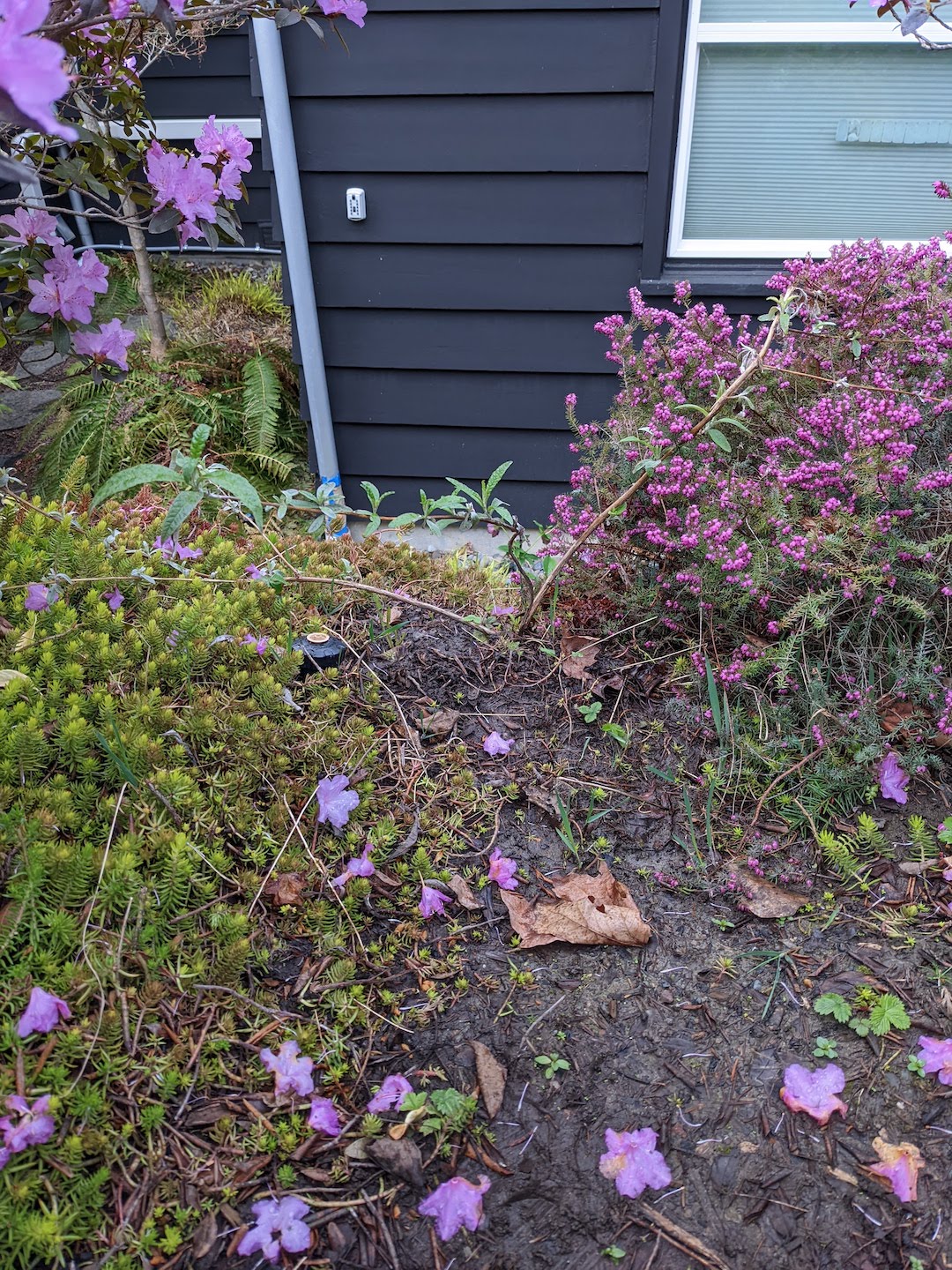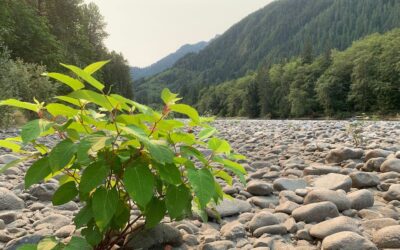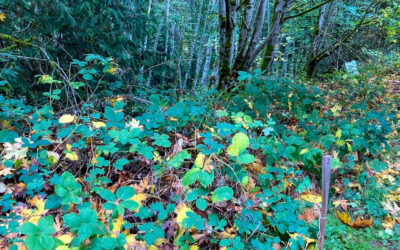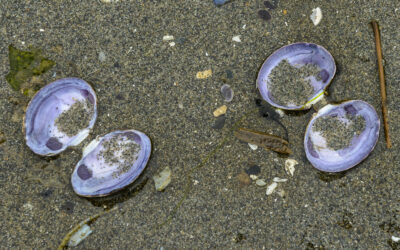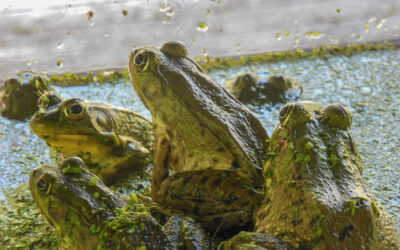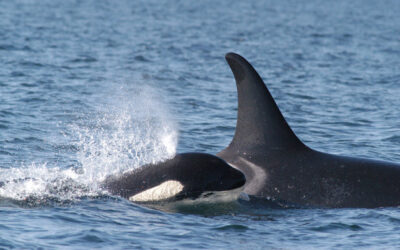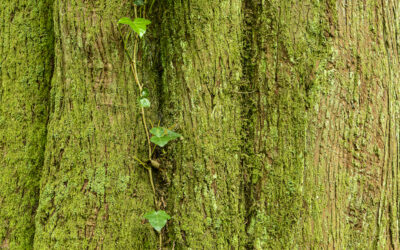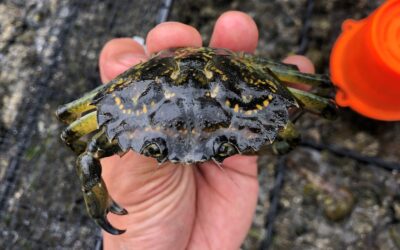GARDEN ESCAPEES
by Sarah Lorse (photos also by Sarah)
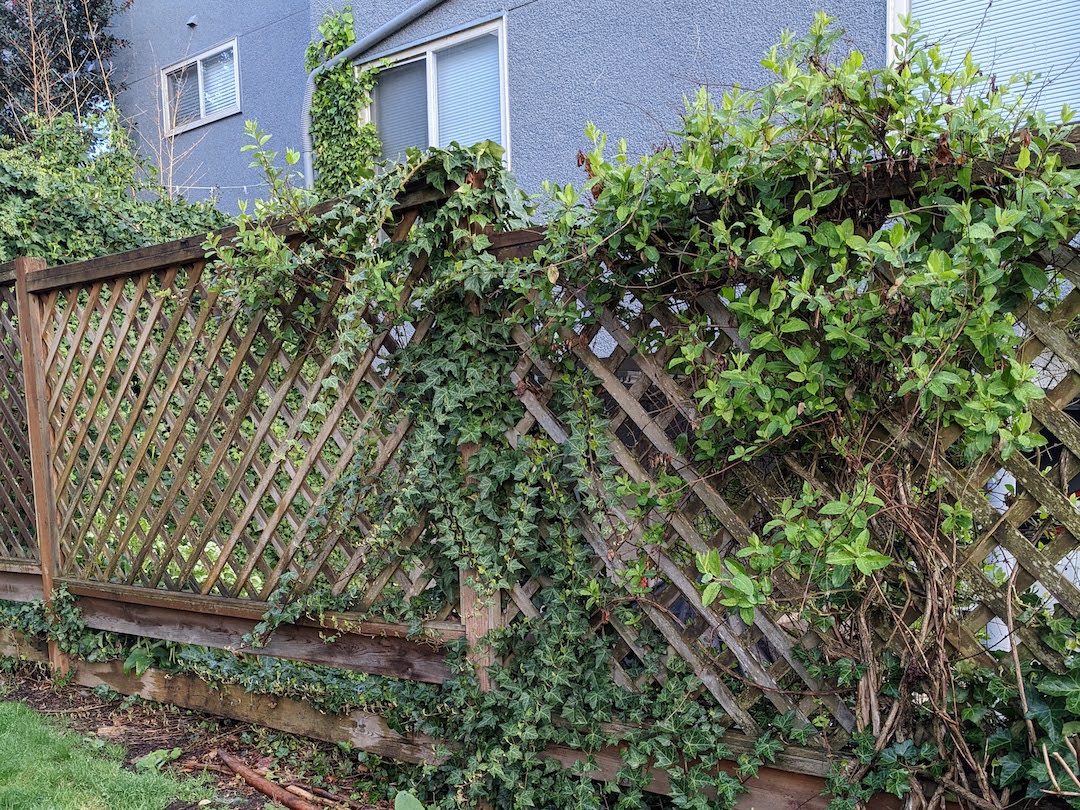
English ivy (Hedera helix) creeps through the fence and overwhelms an intentionally planted native orange honeysuckle (Lonicera ciliosa).
GARDEN ESCAPEES
by Sarah Lorse (photos also by Sarah)
Issue 16, Summer 2022
It is easy for us gardeners to pick out plants that look beautiful, pop them in the ground, and not give a thought to their possible impacts. While we may “own” our gardens and yards, nature does not acknowledge property lines. Our outdoor spaces, even the cultivated ones, are very much part of the local ecosystem and impact it for better and worse.
People move around and take the plants they love with them. These new plants might stay where they are put in a garden and have a low impact on the surrounding area, but other times these new plants escape the confinements of the garden and can wreak havoc. Many of the plants that become listed as invasive or noxious are introduced to new places by people who want to bring a bit of home with them. While the sentiment is understandable, the unforeseen consequences can be devastating.
 Lab Girl
Lab Girl
By Hope Jahren
Click to see Wikipedia entry.
As Hope Jahren writes in her book, Lab Girl,
The vast majority of vines found in North America are invasive species whose seeds were accidentally imported from Europe and Eurasia…Many who immigrated to America during the nineteenth century built a spectacular fortune in a new land. Freed from the torment of insects that had exploited their weaknesses generation after generation for millennia, these vines also flourished in the New World unfettered.
The world of horticulture uses many different terms to describe weeds. Here are some commonly used terms that we use to help talk about the plants in our farms and gardens:
- Introduced Plant Species: Non-native plants which are introduced into new environments, but don’t necessarily spread into non-cultivated areas, such as many agricultural crops
- Invasive Plant Species: A plant that is non-native that causes harm to the environment it is brought into
- Native Plant: A plant that has evolved in and is adapted to its specific environment
- Noxious Weed: A plant that is harmful to people, animals, agriculture, or recreation
- Ornamental: A species that is planted primarily for its aesthetics
- Weed: A plant growing where it is not wanted (it can be a matter of perspective: for example, moss in a lawn is considered a weed by some, tolerated or even accommodated by others)
A tenacious butterfly bush (Buddleja davidii), the small plant in the center of the photo, took up residence at the top of a rockery, making it hard to dig out.
The Find Out More section below contains some links to information about invasive species in British Columbia and in Washington State. In the United States, noxious weeds are designated at the county, state, and federal levels. “Noxious weed” is a legal term that helps government agencies create regulations around the sale and management of specific plant species, and are often divided into three categories:
- Class A: The plant has a limited distribution, and strong effort is put into preventing further spread
- Class B: The plant has spread more but is still contained to certain areas, and the focus may be on prevention or control depending on location
- Class C: The plant is widespread with minimal ability to reduce its continued spread
Some, but not all, noxious weeds are illegal to trade or sell. As gardeners, it is our responsibility to stay educated about what non-native plants are fine for our gardens and which to avoid. If we are not aware of which plants cause problems, it is too easy for us to share them, trade them, or take cuttings to propagate and unknowingly support their side in the battle against invasives.
 See more about Washington’s Noxious Weed Laws and classes of weeds.
See more about Washington’s Noxious Weed Laws and classes of weeds.
Despite a lack of legs, plants are very skilled at getting around. Life is very persistent, and when species reproduce, their DNA is passed on to the next generation. Many plants increase the chances of their genetic survival by spreading their seeds. However, not all plants use the same mechanisms for seed dispersal. It is important for the gardener to understand these mechanisms when thinking about how to reduce the spread of invasive plants. Common methods of seed dispersal include:
- Animals: For many plants, animals are vital to seed dispersal. Fruits, nuts, and seeds provide food for animals who will consume and drop the seed elsewhere. Other plants have hooks on the seeds which attach to fur or shoelaces and use the free ride to get to a new location.
Example: English Holly (Ilex aquifolium) has berries and Cleavers (Galium aparine) uses burrs - Ballistics: As the seeds mature, they increase in size and eventually burst out of the pod, shooting in many directions.
Example: Hairy Bittercress (Cardamine hirsute) - Gravity: Seed dispersal by gravity is simple; when the seeds are mature, they just fall to the ground.
Example: Black Locust (Robinia pseudoacacia) - Water: For plants that like to grow in damper conditions, water is an easy way to send their seeds off into the world with floating seed pods.
Example: Yellow Flag Iris (Iris pseudacorus) - Wind: The wind is a powerful force that can be used to transfer seeds very long distances. Some seeds have structures that catch the wind, and off they go. Other plants use the wind to tumble the entire plant across the ground; as it rolls, seeds fall out.
Example: Mediterranean Sage (Salvia aethiopis) tumble and Butterfly Bush (Buddleja davidii) seeds float
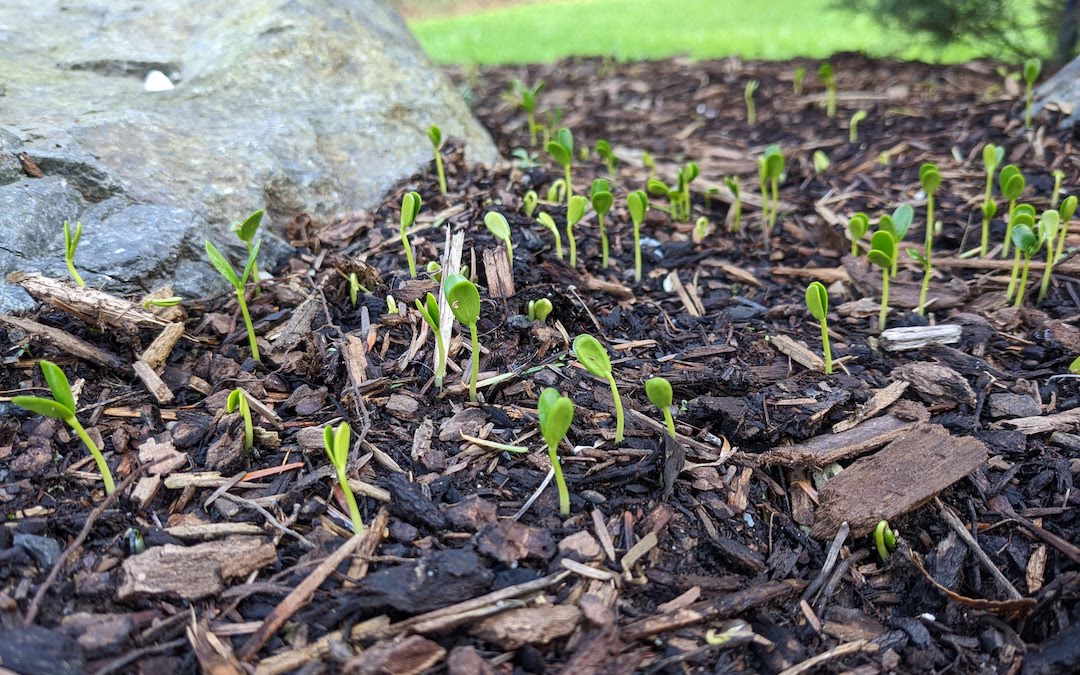
Spurge laurel (Daphne laureola) seedlings. Although the mother plant was removed, her seeds were already in the ground.
While some plants rely on a single method for spreading their offspring, other plants use multiple methods. Sometimes, in addition to seeds, plants will have runners or rhizomes that will spread, and new stems grow from nodules, or tiny pieces of the broken stem will root into the ground.
When a plant is introduced to a new environment, whether on purpose or accidentally, it may immediately die, survive but stay contained, or widely spread. There are several characteristics that invasive plants have in common which allow them to invade successfully, and invasive plants may display some or all of these:
- Rapid Growth
- Prolific Seed Production
- Highly Successful Seed Dispersal and Germination
- Multiple methods of reproduction
- A wide range of tolerance for climatic conditions such as temperature and precipitation
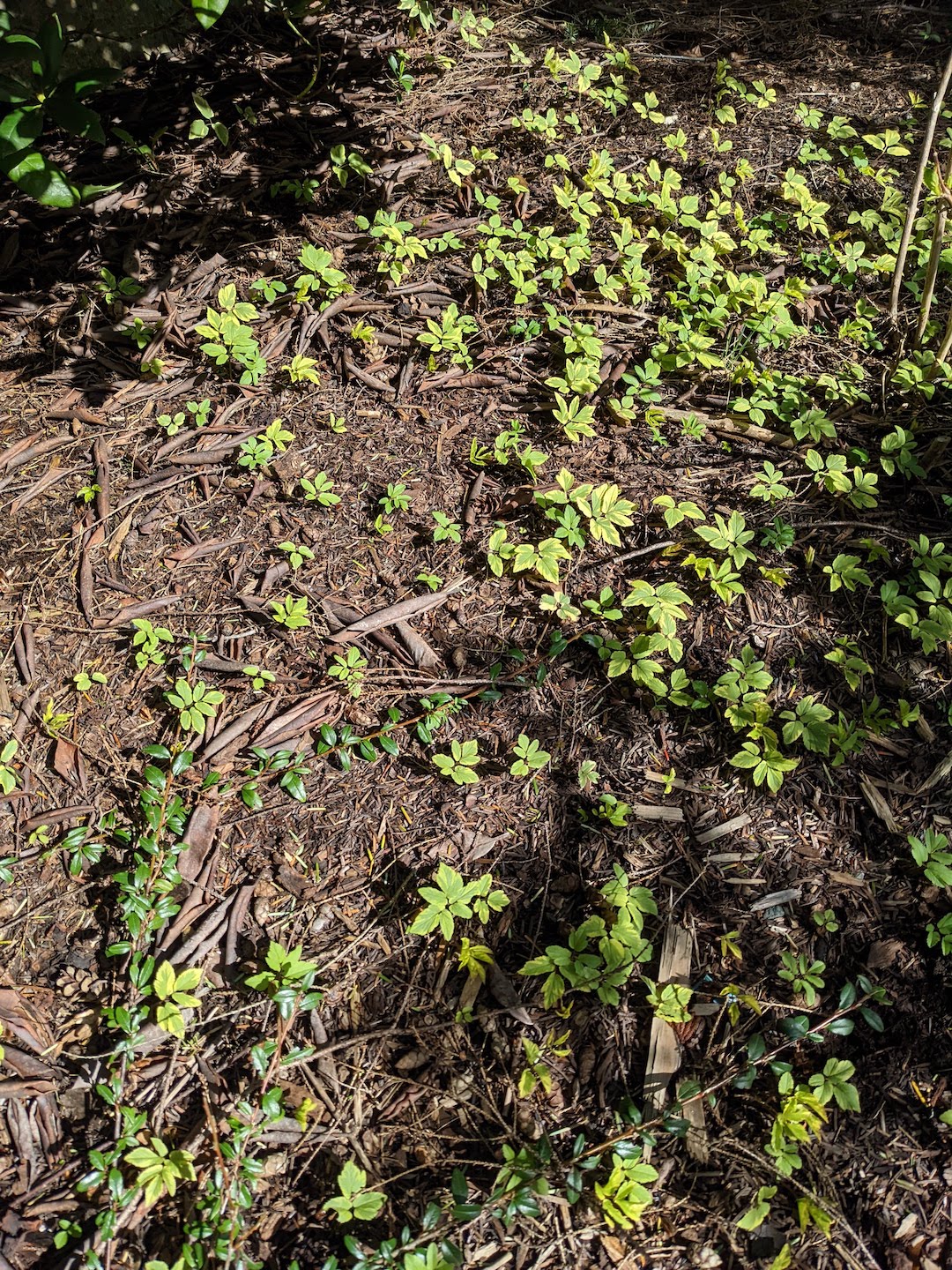
Bishop’s weed (Aegopodium podagraria) is considered invasive in King County and rapidly spreads via rhizomes and seeds.
It can take time for a species to be recognized as invasive, and by the time it is, it may no longer be realistic to control. Gardeners can help prevent the spread of potentially invasive plants by monitoring their gardens. If a plant is displaying one or more of the characteristics above, take action by removing seedlings, cutting off flower heads before they go to seed, and pulling up rhizomes.
As gardeners, we can choose to focus on our garden and what we want solely, or we can choose to see how our gardens are part of the ecosystem. The Washington Noxious Weed Control Board has information for property owners on how to be a Yard Guard, someone who pays attention to what is growing and takes action if an invasive plant is growing.
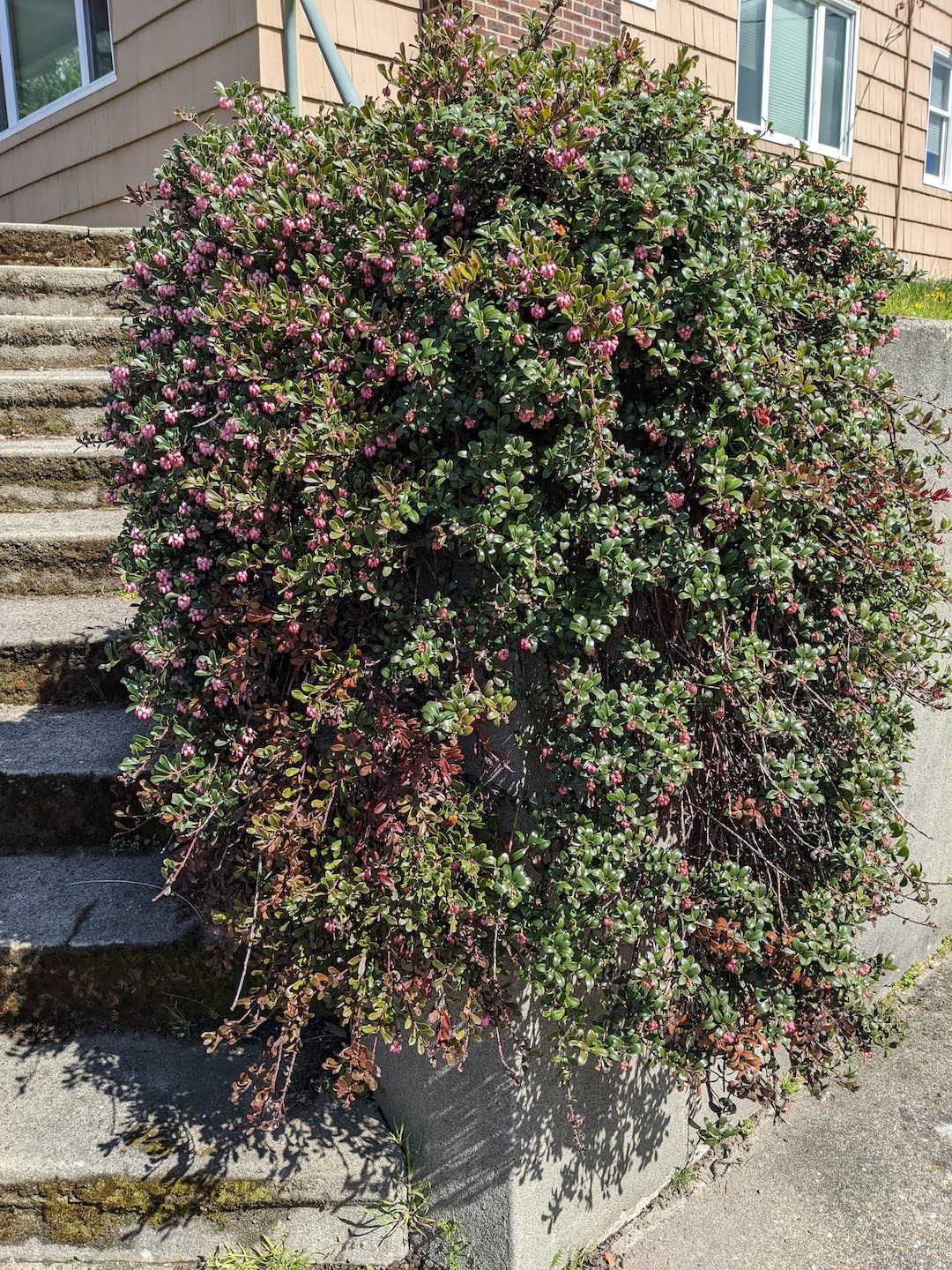
Kinnikinnick (Arctostaphylos uva-ursi) is a native plant that is a great ground cover or looks beautiful cascading over rockeries.
Native plants are often passed over for more showy ornamentals. However, native plants have many benefits introduced plants do not have. Native plants provide food and shelter for wildlife native to the area. Additionally, native plants are used to their local climate, which means they require less water in the summer; needing to water less means more money in your pocket and more water in local rivers. Adaptations to local soils mean native plants do not need supplemental nutrients from fertilizers.
Besides being lower maintenance and benefiting wildlife, native plants work together as a plant community, supporting one another in ways non-native plants cannot. Red alder (Alnus rubra) is one of the first trees to grow on disturbed sites. The alder plays host to nitrogen-fixing bacteria in its roots. Wherever red alder grows, it enhances the soil around it by adding nitrogen to it. The addition of usable nitrogen is vital for other plants to grow.
Orange honeysuckle (Lonicera ciliosa) is a twining vine, a vine that haphazardly wraps around its support instead of using tendrils, sucker discs, or aerial rootlets. The native honeysuckle relies on other plants such as oceanspray (Holodiscus discolor) and Pacific ninebark (Physocarpus capitatus) to be its structure as it climbs its way towards the sun. The structure plant is not harmed, and the honeysuckle, a pollinator favorite, helps attract wildlife which benefits the plant community as a whole.
A limited amount of research on native plant communities has been done, so the chances are high that native plants support each other in ways we do not even know about. By planting a few (or a lot) of natives in your landscape, you will be making less work for yourself and benefiting the local ecosystem.
Gardening is a marvelous activity for both mental and physical health. We can turn our garden into something that benefits much more than just ourselves with just a little thought. Happy gardening!
FIND OUT MORE
nuisance plants
- Invasive Plant Atlas of the United States
- Federal Noxious Weeds
- Washington State Noxious Weed Control Board
- Washington’s Noxious Weed Laws
- Washington Invasive Species Council
- County Weed Boards
native plants
- Washington Native Plant Society
- King County Native Plant Guide
- PlantNative
- Real Gardens Grow Natives by Eileen Stark
- Gardening With Native Plants of the Pacific Northwest by Arthur R. Kruckeberg
- Native Plants in the Coastal Garden by April Pettinger
- Garden Wise (provides native and non-native alternatives to noxious weeds)
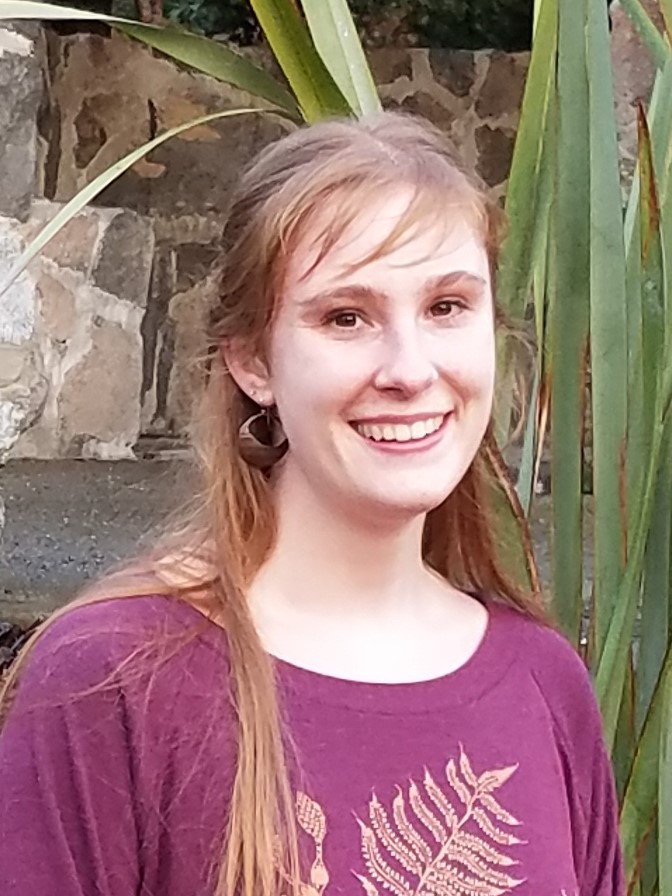
Sarah Lorse is a Seattle-born naturalist, writer, and photographer. She has worked many jobs in the environmental field and is currently working as an organic landscaper. She loves to connect others to nature through her work, whether it is teaching about the benefits of native plants or encouraging responsible recreation practices.
When she is not working, she can be found playing outside. She loves climbing (rocks, mountains, and trees), gardening, and just observing the natural world.
You can find more of her work on her website www.naturewritten.com or by following her on social media @flora_nativa_.
Table of Contents, Issue #16, Summer 2022
Story of Knotweed
By Skye Pelliccia, Summer 2022 King County Noxious Weed Control ProgramYoung late-spring knotweed on gravel. photo by Sara Price, KCNWCPBy Skye Pelliccia, Summer 2022 King County Noxious Weed Control ProgramIf the timeline of Earth’s history stretched across your arm...
CWMA photos
by Douglas Crist — Issue 16, Summer 2022Friends of the Farms partnering with Island School to clear invasive species and establish native, primarily edible plants at the Bainbridge Island Native Food Forest. An educational ecosystem restoration project, building...
Double Jeopardy
The Intersection of Climate Change and Invasive Species By Paul Heimowitz, Summer 2022Purple varnish clam. photo by John F. WilliamsThe Intersection of Climate Change and Invasive Species By Paul Heimowitz, Summer 2022The arrival of non-indigenous people to the Salish...
Green Frog
Female green frog at county stormwater pond #147. photo by Elizabeth Springborn Melissa Fleming, Ph.D.Photos by Melissa Fleming except as notedSummer 2022The green frog (Lithobates [Rana] clamitans) is the classic frog of my East Coast childhood: often the size of...
Invasives and killer whales
Orca mother and child. photo courtesy of NOAATara Galuska, Governor’s Salmon Recovery OfficeChelsea Krimme and Justin Bush, Washington Invasive Species Council Summer 2022The image of a large, black-and-white killer whale jumping from the water before falling back...
Poetry-16
Summer 2022Western redcedar. photo by John F. WilliamsSummer 2022INVASION by Diane Moser Beneath my windowcedars as old as Lewis and Clarkeclimb skywardreaching for rain and morning light. They try to ignore the ivythat climbs their trunk,invasive tentacles...
European Green Crab
the key to management success is community collaboration By Leah Robison (Northwest Straits Commission) and Chase Gunnell (Washington Department of Fish and Wildlife), Summer 2022Large European green crab. photo by by Jonathon Hallenbeckthe key to management success...
PLEASE HELP SUPPORT
SALISH MAGAZINE
DONATE
Salish Magazine contains no advertising and is free. Your donation is one big way you can help us inspire people with stories about things that they can see outdoors in our Salish Sea region.
We also don't advertise Salish Magazine, so please spread the word of this online resource to your friends and colleagues.
Thanks so much for your interest and your support.
We also don't advertise Salish Magazine, so please spread the word of this online resource to your friends and colleagues.
Thanks so much for your interest and your support.

